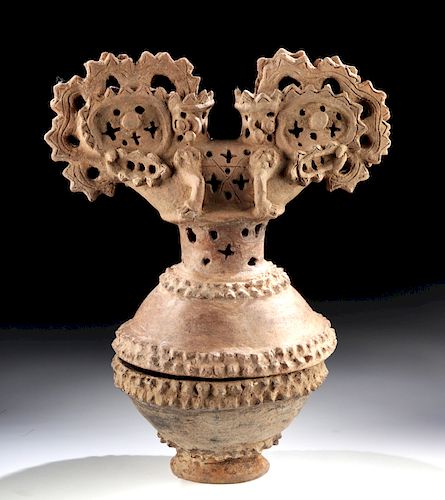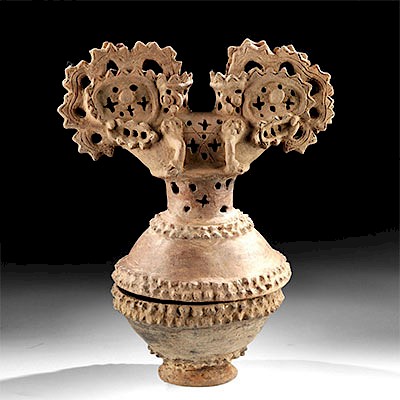Chiriqui Pottery Incensario with Janus Headed Crocodile
Lot 126
About Seller
Artemis Fine Arts
686 S Taylor Ave, Ste 106
Louisville, CO 80027
United States
Selling antiquities, ancient and ethnographic art online since 1993, Artemis Gallery specializes in Classical Antiquities (Egyptian, Greek, Roman, Near Eastern), Asian, Pre-Columbian, African / Tribal / Oceanographic art. Our extensive inventory includes pottery, stone, metal, wood, glass and textil...Read more
Categories
Estimate:
$5,000 - $8,000
Absentee vs Live bid
Two ways to bid:
- Leave a max absentee bid and the platform will bid on your behalf up to your maximum bid during the live auction.
- Bid live during the auction and your bids will be submitted real-time to the auctioneer.
Bid Increments
| Price | Bid Increment |
|---|---|
| $0 | $25 |
| $300 | $50 |
| $1,000 | $100 |
| $2,000 | $250 |
| $5,000 | $500 |
| $10,000 | $1,000 |
| $20,000 | $2,500 |
| $50,000 | $5,000 |
| $100,000 | $10,000 |
| $200,000 | $20,000 |
About Auction
By Artemis Fine Arts
Aug 22, 2019
Set Reminder
2019-08-22 10:00:00
2019-08-22 10:00:00
America/New_York
Bidsquare
Bidsquare : Fine Ancient | Asian | Ethnographic Art
https://www.bidsquare.com/auctions/artemis-gallery/fine-ancient-asian-ethnographic-art-4348
Featuring classical antiquities, ancient and ethnographic art from cultures encompassing the globe, plus fine art. Egyptian, Greek, Roman, Etruscan, Near Eastern, Asian, Pre-Columbian, Native American, African / Tribal, Oceanic, Spanish Colonial, Russian, Fine Art, so much more! Artemis Fine Arts info@artemisgallery.com
Featuring classical antiquities, ancient and ethnographic art from cultures encompassing the globe, plus fine art. Egyptian, Greek, Roman, Etruscan, Near Eastern, Asian, Pre-Columbian, Native American, African / Tribal, Oceanic, Spanish Colonial, Russian, Fine Art, so much more! Artemis Fine Arts info@artemisgallery.com
- Lot Description
Pre-Columbian, Costa Rica or Panama, Chiriqui, ca. 1000 CE. A fabulous two-part incensario presenting a janus-headed crocodile finial on the lid, so finely hand-modeled and designed with openwork jagged frills, high relief eyes and legs, and numerous circular and cross-shaped perforations for smokey plumes from burning incense to waft through. Surfaces of the lower lid and vessel bowl are covered with repeated raised pointed knobby motifs, as if to represent the skin of the crocodile. The deep bowl is large enough to contain a substantial amount of kopal or another aromatic substance. Once heated, the fragrance would waft upward and through the openings on the lid. Size: 11" W x 14" H (27.9 cm x 35.6 cm)
The iconography on this piece is especially symbolic. The Crocodilian order, comprised of crocodiles, smaller alligators, and yet smaller caymans (all treated similarly in Pre-Columbian mythology) was very meaningful to the ancients of the Americas. The crocodile being the oldest (approximately 55 million years old) was understood as a crocodilian earth monster and is oftentimes shown giving rise to what was known as the World Tree. Partial to a watery habitat, the crocodile is also a metaphor for fertility.
"Ceramica de los Ancestros: Central America's Past Revealed" - exhibition at the National Museum of the American Indian George Gustav Heye Center (New York, New York, USA - April 18, 2015- May 20, 2018) featured examples similar to this one.
Provenance: private Hawaii, USA collection; ex-Fred Eisermann collection, Dallas, Texas, USA
All items legal to buy/sell under U.S. Statute covering cultural patrimony Code 2600, CHAPTER 14, and are guaranteed to be as described or your money back.
A Certificate of Authenticity will accompany all winning bids.
We ship worldwide and handle all shipping in-house for your convenience.
#148356Lid professionally repaired from about a half dozen pieces. Stabilized crack from rim of lower bowl. Lid and bowl/receptacle fit together very well. Normal surface wear and abrasions to high pointed areas commensurate with age. Surfaces are covered with liberal manganese deposits and earthen deposits. Nice root marks. Collection labels under the lid and on underside of the bowl's base.Condition
- Shipping Info
-
All shipping is handled in-house for your convenience. Your invoice from Artemis Gallery will include shipping calculation instructions. If in doubt, please inquire BEFORE bidding for estimated shipping costs for individual items.
-
- Buyer's Premium



 EUR
EUR CAD
CAD AUD
AUD GBP
GBP MXN
MXN HKD
HKD CNY
CNY MYR
MYR SEK
SEK SGD
SGD CHF
CHF THB
THB
















